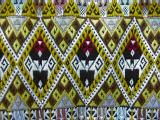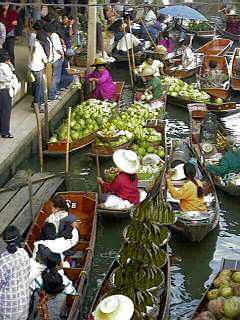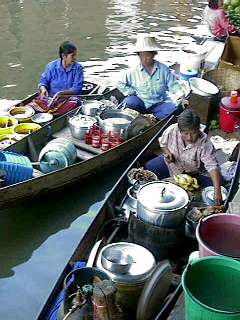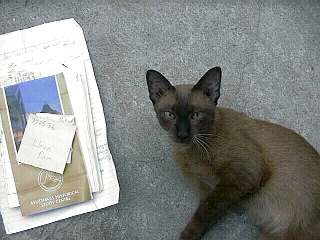 THAILAND--Part Four
THAILAND--Part Four
Central Thailand
Central Thailand is the country's "rice bowl": here, the Chao Phraya River (that runs into Bangkok) meanders through a fertile plain where the soil is so good that farmers can grow more than one crop of rice per year. Some sources I read say that this area actually is the most productive for rice growing in all of Asia! The cities of Nakhon Pathom and Kanchanaburi, which I already described, are in Central Thailand, as are two other important places I visited: Damnoen Saduak and Ayutthaya.
 This
is a photo of the floating market at Damnoen Saduak. It always amazes me
to see how people adapt their lifestyles to the places they live. Here,
where there's lots of water and people build their homes along the canals,
the people get around by boat, and even the places they shop are on the
water.
This
is a photo of the floating market at Damnoen Saduak. It always amazes me
to see how people adapt their lifestyles to the places they live. Here,
where there's lots of water and people build their homes along the canals,
the people get around by boat, and even the places they shop are on the
water.
 People
bring their boats together to buy things from each other, to trade their
goods, or just to chat. They often eat together, too. One of the best meals
I had in Thailand was from one of these boats -- they'd just caught the
fish they served me minutes before it hit my plate!
People
bring their boats together to buy things from each other, to trade their
goods, or just to chat. They often eat together, too. One of the best meals
I had in Thailand was from one of these boats -- they'd just caught the
fish they served me minutes before it hit my plate!
 Traveling
to the north, you soon come to the capital of ancient Siam and one of the
most glorious cities of the medieval world, Ayutthaya. Ayutthaya was built
in 1350 and served as the capital city until 1767, when it was destroyed
by invading Burmese armies. Before its destruction, during the 1600's, it
was probably the major power in all of Southeast Asia. While most of the
ancient city is in ruins, you can still see wats like this that are a testament
to its former glory. There is a wonderful museum in town that has models
of the city as it was, with gorgeous palaces, glittering temples, busy markets
and a port that was a host to sailing ships from all over the world. What
you can't see there are the great works of literature, poetry, drama, dance
and music that the people of Ayutthaya also developed during this high point
in Thai history.
Traveling
to the north, you soon come to the capital of ancient Siam and one of the
most glorious cities of the medieval world, Ayutthaya. Ayutthaya was built
in 1350 and served as the capital city until 1767, when it was destroyed
by invading Burmese armies. Before its destruction, during the 1600's, it
was probably the major power in all of Southeast Asia. While most of the
ancient city is in ruins, you can still see wats like this that are a testament
to its former glory. There is a wonderful museum in town that has models
of the city as it was, with gorgeous palaces, glittering temples, busy markets
and a port that was a host to sailing ships from all over the world. What
you can't see there are the great works of literature, poetry, drama, dance
and music that the people of Ayutthaya also developed during this high point
in Thai history.
The myth of the establishment of Ayutthaya is a great one (there are LOTS of great stories in Thai history):
|
HOW AYUTTHAYA CAME TO BE "According to tradition, there once was a king who had a beautiful daughter. One day, the princess was served an eggplant which had been grown by an ugly gardener. The gardener was called Nay Saen Pom, or "Mister Hundred Thousand Blotches," because his body was covered with ugly blotches from head to toe. After eating the eggplant, the princess became pregnant. The king was understandably upset, but decided to wait until the child -- a boy -- was born. Then he summoned all the men in his kingdom, and ordered them to offer food to the baby. The man whose food offering the child accepted would be declared the legal father and would marry the princess. Needless to say, all the men in the kingdom were very excited about the prospect of marrying the princess. They procured the best delicacies money could buy, and set out for the palace, where they offered them to the young boy. To their disappointment, the boy refused to touch any of the food. Nay Saen Pom, being but a poor gardener, could not afford to buy anything special, and brought the only food item he could find at home, a lump of cold, leftover rice. To everyone's amazement, the baby reached for the cold rice and ate it up. When the king found out his prospective son-in-law was a lowly gardener, and an ugly one at that, he was enraged. He ordered his daughter, together with Nay Saen Pom and the child, be put on a raft and floated down the Chao Phraya river, away from his kingdom. The raft floated downstream for a while, and then landed at Nay Saen Pom's vegetable garden. There the Hindu god Indra, patron of the unfortunate, appeared to nay Saen Pom and gave him a magic drum. Each time the drum was beaten, Indra would appear and grant him any wish, up to three times. Nay Saen Pom took advantage of all three wishes. First, he wished his blotches would disappear, whereupon he became a very handsome man. Then he wished for a city to rule over, and again Indra granted his wish and created a city for him. Finally, he asked for a golden cradle for his son. The young prince was named U Thong (pronounced oo tong), which means "golden cradle" When Nay Saen Pom died, U Thong succeeded him as king, and named his city U Thong after himself. For six generations, Nay Saen Pom's descendants ruled the city, all under the name of U Thong. During the reign of U Thong VI a cholera epidemic swept through the city, and the king and his court were forced to flee southwards. They chose a strategically located island in the Chao Phraya river, and established a new city there. King U Thong VI named his new city Ayutthaya, after a holy city in northern India. From "Thailand: Land of Contrasts" by Titima Suthiwan and Uri Tadmor, published in 1998 by the Center for Southeast Asian Studies, School of Hawaiian, Asian an Pacific Studies, University of Hawai'i |
 Walking
around the ruins, I came across this beautiful cat. I wasn't sure until
I showed the picture to someone who's a cat fanatic, but she assured me:
it's a Siamese cat! I never thought I'd actually see a Siamese cat in Siam
(the ancient name for Thailand), but I guess I just got lucky.
Walking
around the ruins, I came across this beautiful cat. I wasn't sure until
I showed the picture to someone who's a cat fanatic, but she assured me:
it's a Siamese cat! I never thought I'd actually see a Siamese cat in Siam
(the ancient name for Thailand), but I guess I just got lucky.